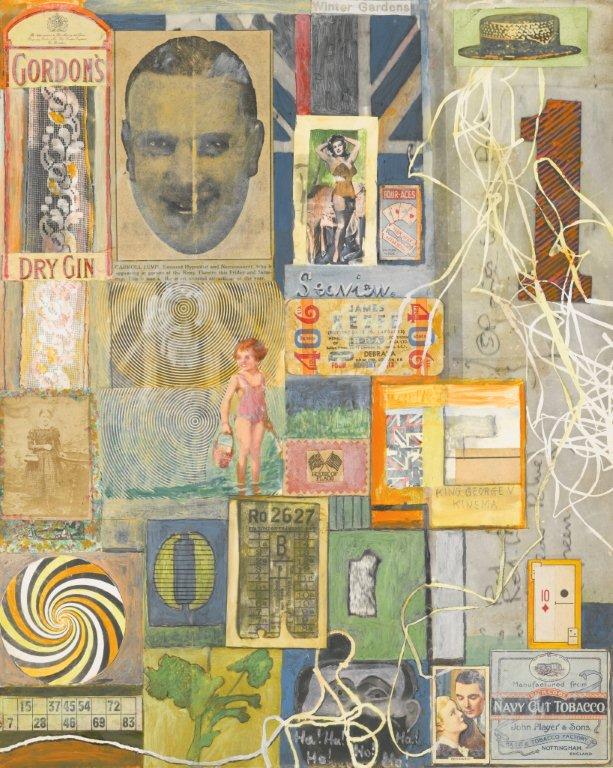Nigel Henderson (1917-1985)
Lucky 13, from the Lovely Linda series
Collage, watercolour and gouache
50 x 40 cm.
circa 1977
In the 1970s, Henderson began a new approach to his collages. He would take a single found image – in this instance a print of a woman found on the floor of a bus – and work through various imaginary scenarios until all possibilities were fully exhausted. ‘The first example of this new approach came about in the late 1970s in what is known as the Lovely Linda series, when a student of Henderson’s showed him a print of a woman he had found on the floor of a bus and of which Henderson imagined that “it must have fallen from a wallet, where it had been conserved lovingly, gazed upon from time to time to provide a momentary lift – like a double-whisky”’.
As Henderson wrote of this series; ‘It incorporates a timeless whore (call girl, fun girl, artist’s moll) in the centre of the picture, ringed by a dartboard ring of numbers (pushed out of shape to act like a garland [up in Mabel’s room is a dart player’s euphemism for double one]) so perhaps she’s ‘Mabel’. Around are scenes – or bits rather suggesting a sexy escapade’.
(see V. Walsh, Nigel Henderson, Parallel of Life and Art, London, 2001, pp. 133-134).
Nigel Henderson (1917-1985)
Childhood visit to the seaside
Collage, watercolour, gouache and pencil over a printed base
51 x 40 cm.
Both the present work and Lucky 13 were in the collection of the sculptor Barry Flanagan. Henderson was appreciated by other artists as a great conduit of ideas and information. His friendships with key international Surrealists and his age when he arrived at the Slade School after WWII marked him out to a younger generation of artists.
Nigel Henderson Biography (1917-1985)
As a young man in inter-war London, Henderson had first hand contact with international artistic developments through his mother, who set up the collector Peggy Guggenheim’s London gallery in 1938. Through her, Henderson met such leading Surrealists as Marcel Duchamp, Max Ernst and Yves Tanguy, and his work was included alongside Picasso and Braque in a show of collage work.
Henderson was also friendly with members of the Bloomsbury Group, and in 1943 married Virginia Woolf’s niece.
After serving in World War II, Henderson studied at the Slade School of Art, where he met fellow artists Eduardo Paolozzi, William Turnbull and Richard Hamilton. Henderson’s lifelong friendship with Paolozzi is considered crucial to the development of British Pop Art. In 1952, they were both founder members of The Independent Group. This was a highly significant group of artists, writers and thinkers which met at the Institute of Contemporary Arts.
Henderson worked in a variety of media, including photography, but is best known for his collage works. He contributed to the seminal ‘This is Tomorrow’ exhibition at the Whitechapel Gallery in 1956. His work features in many public collections including Tate, V&A, the Pompidou Centre, Paris and MOMA, New York.



